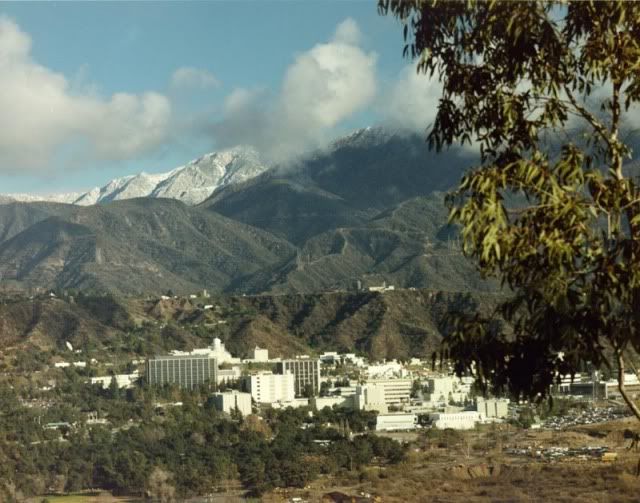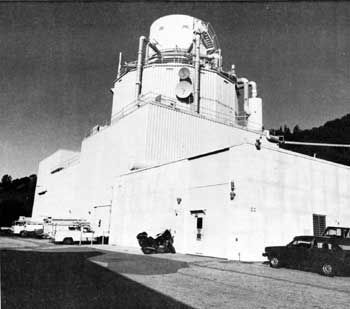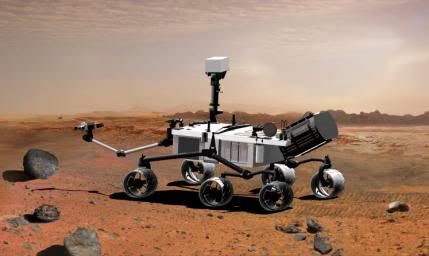
I grew up a NASA kid able to mark periods of my life by the missions everyone was working on. I remember going to the public open houses, and if you live anywhere near I highly suggest you attend, but I never got the backstage tour, so when I got an e-mail last week from one of the ladies I consider one of my parents (My family is a little different have a read here if you're interested) asking if I’d like to check out the Mars Science Laboratory I couldn’t say yes please fast enough.
The Jet Propulsion Laboratory's history reaches back to the tumultuous years leading up to World War II. Rockets were perceived as devices of fantasy, seen only in movie serials and comic strips like Buck Rogers and Flash Gordon. Despite rocket pioneer Robert Goddard’s successful development of early rockets, he was publicly ridiculed for his work. But in the fall of 1936, a group of enterprising young men in Pasadena, Calif., decided to risk their reputations and give engineering substance to rocket fantasyJPL history link
The "rocket boys" were an unusual bunch. Frank Malina was studying aerodynamics at Caltech's Guggenheim Aeronautical Laboratory, known as GALCIT. Jack Parsons was a self-taught chemist, and Ed Forman was an excellent mechanic. They scraped together cheap engine parts, and on Oct. 31, 1936, drove to an isolated area called the Arroyo Seco at the foot of the San Gabriel Mountains.
Four times that day they tried to test fire their small rocket motor. On the last attempt, they accidentally set fire to their oxygen line, which whipped around shooting fire! These were the first rocket experiments in the history of JPL. They tried again on Nov. 15, 1936, and their experiment finally worked
Visitors are only allowed 2 hours on the lab’s campus now. Back in the day I understand that restriction didn’t exist so the tour my host gave included lunch and educational videos in her office, but since we were limited we were going to have to apparently hustle. The security was appropriate and fast so we were soon checked in and on our way. The museum was full of kids, and that gave me hope. The museum has either a mock up, or the actual test vehicle for every mission JPL has been involved in including Voyager which is just one big instrument 1592 pounds. It absolutely filled the center of the museum and considering when it was launched 1977 it still looks like a state of the art devise.
July 1957 marked the beginning of the International Geophysical Year, when scientists around the world planned to jointly observe various scientific phenomena. It was during this period of scientific cooperation that the Soviet Union stunned the world with the launch of Sputnik, the first satellite ever. On October 4, 1957, the USSR put into orbit a tiny sphere with a radio transmitter that beeped its way into history. The JPL community was surprised that the Soviets could have both a successful launch vehicle and the electronic technology to operate the satellite.JPL history link
The United States needed an immediate response. The first attempt, the Naval Research Lab's Vanguard project, failed. Their rocket exploded in full view of the press, embarrassing the nation.
JPL and the U.S. Army's Ballistic Missile Agency in Huntsville, Alabama, then pooled resources and knowledge. In about 80 days a four-stage rocket was assembled. JPL's canister-shaped Explorer 1 satellite formed the nose of the rocket.
On January 31, 1958, Explorer 1 launched and became the first U.S. satellite, using its single instrument to send back data about the radiation environment high above Earth's surface.
This started the "space race" with the Soviet Union.
One of the things I noticed as we walked around JPL is I didn’t see one unhappy face. I saw people thinking, I saw people hurrying, but I didn’t see anyone sitting around the edges smoking a cigarette with the take this job and shove it look. That must be what it’s like to work on fascinating things you’ve studied your entire life to attain the skills for.
Our next stop was in the mission control center where technician and scientist ride herd on a continuous stream of data from the various active missions in space. I was told when we see the exciting footage of a successful encounter with the bouncing happy mission specialist there is where it is filmed, and the only thing I could think of was man is that space small for its importance. Those people are crammed in that area like sardines.
Outside the mission control center in a fairly long hallway there was a mural that I stared at for a good 5 minutes. It contained in essence art by the mission. When something was completed representatives would paint on the wall. That was killer and at some point that wall is going to need to be preserved.
Our next stop was the testing areas and if there was an area I think I’d have fun working in it was that one. The first stop was the 25ft space simulator. A massive building with the ability to produce a vacuum, and vary its temperature from -185 to +110 degrees C (-300 to +230F). They do this using these massive lightbulbs 25K watts and over 10,000 bucks a piece. It sort of broke my heart when the tech told me that when one fails they tend to do so kind of explosively causing a cascade of exploding 10,000 dollar lightbulbs. The room is huge with a monster crane that takes spacecraft into the capsule for testing. It has interesting mats all over the floor that is almost as sticky as fly paper for dust is the enemy. When I was there they were just completing cleaning the testing space. A piece of dust as small as 100 microns is unacceptable to them, but as they were finished cleaning I got to see the massive 8 ton door to the thing operates. That was something even my host hadn’t seen and it was slicker than snot.

We went by the labs where fine minds think of what will cause a craft to fail, and then set about seeing if it will happen. They shake the heck out of them using sound waves, they blast them with every form of radiation they can simulate, and for the craft that actually explore like the Mars rovers they have a big area they run them around in that simulates the environment.
Motivated by Explorer 1's success, JPL Director William Pickering wanted to move into space exploration. He thought the relatively small, non-profit JPL could never raise the money necessary to remain on the leading edge of rocket technology as much larger aviation companies entered the rocketry business. He convinced the Army and President Eisenhower to make JPL part of the nation's new space agency, the National Aeronautics and Space Administration. In that role, JPL, with its links to Caltech's science community, could lead in the creation of the new realm of space science. In December 1958, the Army formally transferred JPL to NASA, although it remained under Caltech management.JPL history link

Now I know why everyone I know who works at the lab is in good shape. The thing is basically situated against a hill and to walk about the facility like we did is a work out of hill climbing stairs. However, our next and last stop is what I’ve been waiting for the clean room, and the construction of the Mars Science Lab
The thing is big, way bigger than the previous Mars rovers, and the space it is being constructed in is very impressive. First of all it is CLEAN. Where 100 microns would make the people in the space simulators mad that room is angry at half that. Visitors aren’t allowed in there obviously because the workers have to go through a long series of cleaning and blowing before they are allowed in. I was surprised that the actual people who construct the craft are technicians and not engineers. We were lucky in that all the components of the Mars rover were in the room. She’s a complicated thing. They intend to land is using a combination of parachute and “sky crane”. That’s a device with 8 rocket motors that will actually retro rocket the thing down to the surface then when it touches down it will fly off and crash somewhere.
How cool was that! What a fantastic day. I would take an increase in my taxes any day that would assure that these people get to continue to work. I would rather drop billions on the things where they fail then all the money they’ve used to make war.
Update November 26, 2011 and baby is on her way!
Update August 5 2012
We are wheels down on Mars receiving thumbnail pictures!

No comments:
Post a Comment